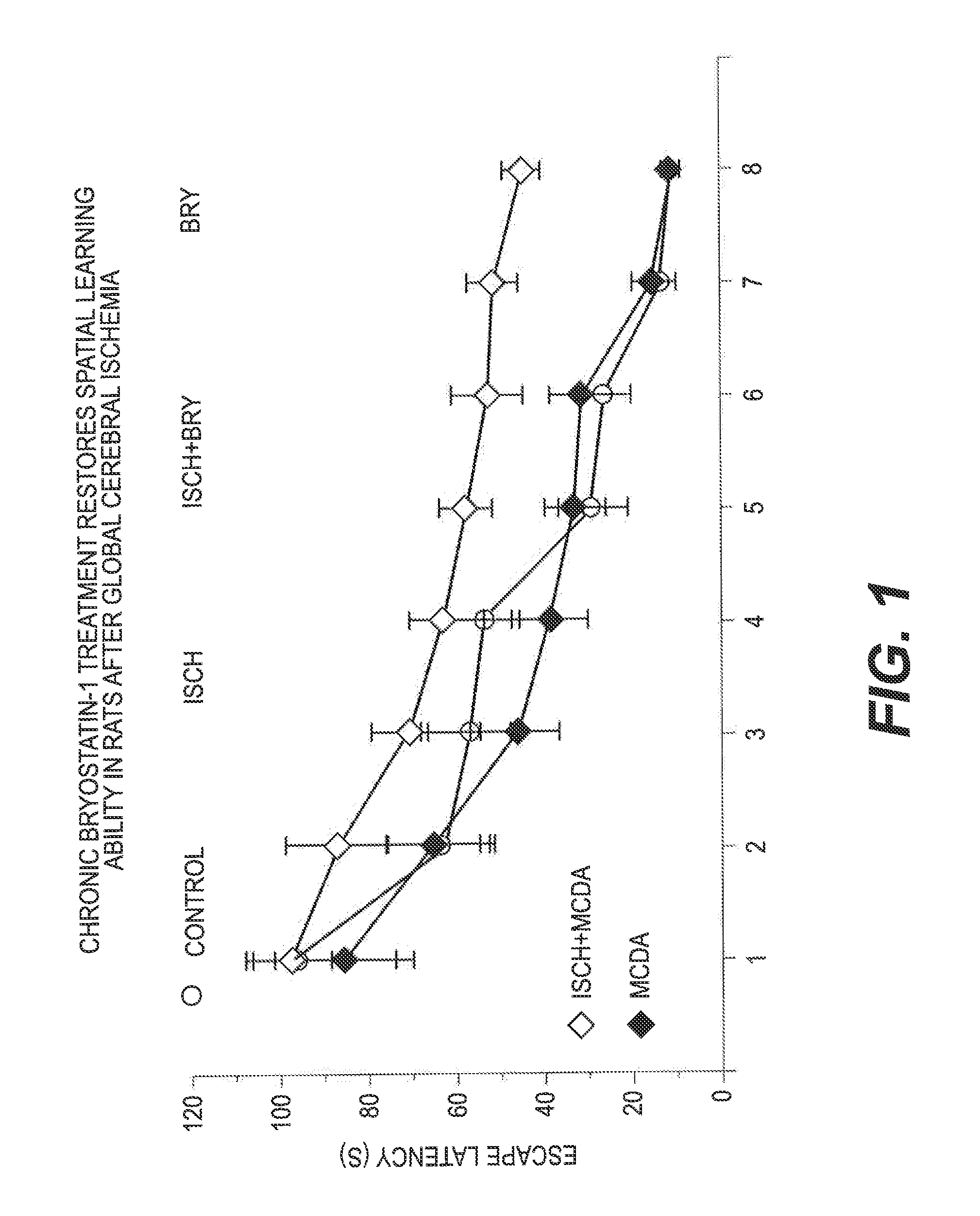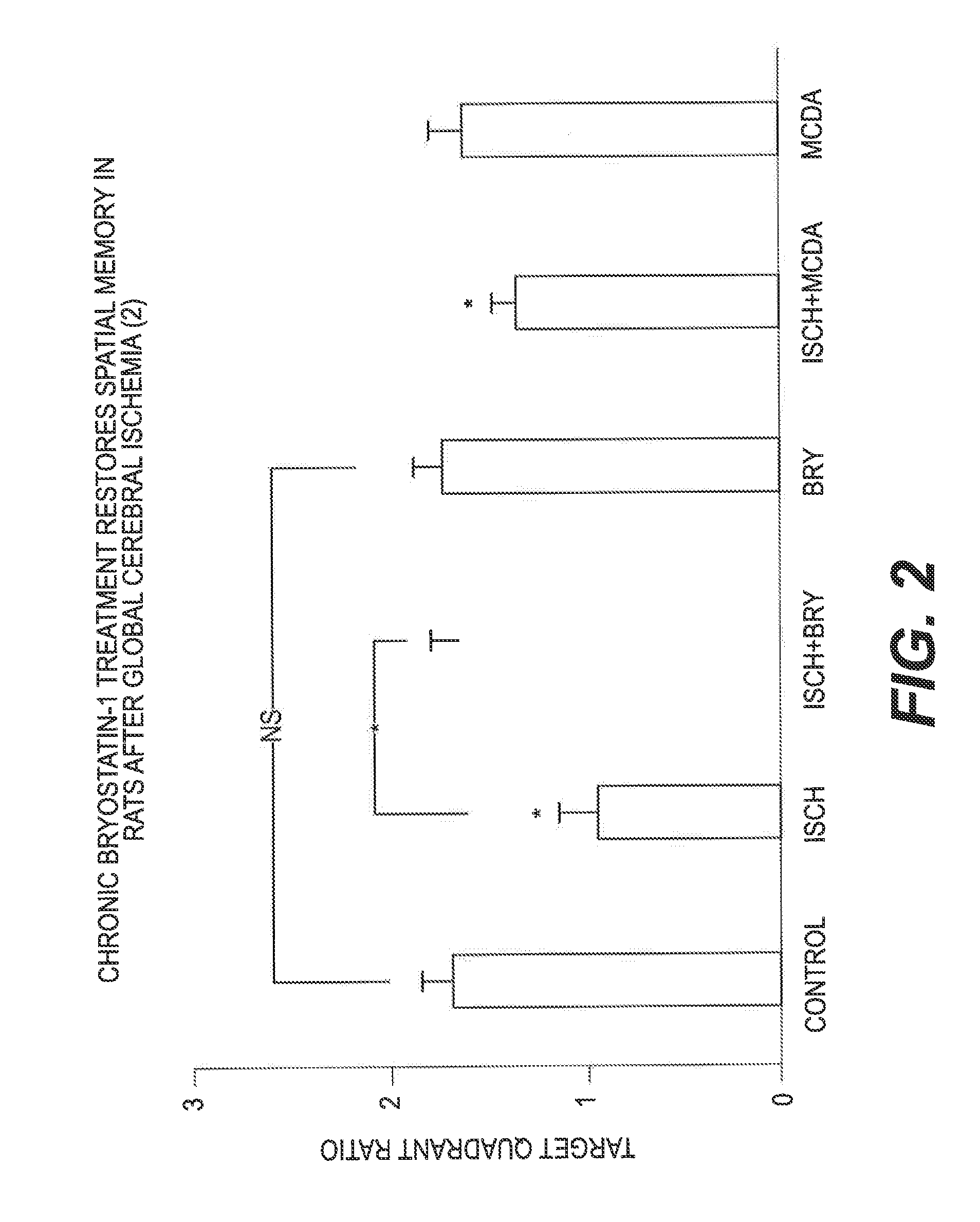Therapeutic effects of bryostatins, bryologs, and other related substances on ischemia/stroke-induced memory impairment and brain injury
a technology of bryostatin and other related substances, which is applied in the direction of biocide, drug composition, peptide/protein ingredients, etc., can solve the problems of brain cells dying or serious damage, affecting local brain function, and affecting the function of brain parts with disturbed perfusion
- Summary
- Abstract
- Description
- Claims
- Application Information
AI Technical Summary
Benefits of technology
Problems solved by technology
Method used
Image
Examples
example 1
Global Ischemia Model of Stroke
[0053]Rats (male, Wistar, 200-225 g) were randomly divided into 6 groups (8 each) and housed for 1 week before experimentation. Transient or permanent restriction of cerebral blood flow and oxygen supply results in ischemic stroke. The global ischemia model used to induce vascular memory impairment was two-vessel occlusion combined with a short term systemic hypoxia. Ligation of the bilateral common carotid arteries was performed under anesthesia (pentobarbital, 60 mg / kg, i.p.). After a one-week recovery from the surgery, rats were exposed to 14-min hypoxia (5% oxygen in a glass jar). Control rats (sham operated and vehicle controls) were subjected to the same incision to isolate both common carotid arteries and to 14-min air (in the glass jar). Body temperature was kept at 37-37.5° C. using a heating light source during the surgical procedure and until the animals were fully recovered.
example 2
Bryostatin and MCDA Treatment
[0054]Bryostatin-1 was administered at 20 μg / m2 (tail i.v., 2 doses / week, for 10 doses), starting 24 hours after the end of the hypoxic event. 4-Methylcatechol-diacetic acid (MCDA, a potential NGF and BDNF booster) was administered at 1.0 mg / kg (i.p., daily for the same 5-week period) in separate groups of rats.
[0055]One week after the last bryostatin-1, MCDA, or vehicle administration, rats were trained in the water maze spatial learning task (2 training trials per day for 4 days), followed by a probe test. A visible platform test was given after the probe test. The results are shown in FIG. 1.
[0056]Overall, there was a significant learning difference between the 6 groups (FIG. 1; F5.383=27.480, p7,63=0.102, p>0.05), a significantly impaired learning as compared with the control rats (group difference: F1,127=79.751, p1,127=72.782, p1,127=0.001, p>0.05). MCDA treatment also improved the learning of the ischemic rats (ischemia with NCDA treatment vs. isc...
example 3
Bryostatin Treatment
[0058]Global cerebral ischemia / hypoxia was induced in male Wistar rats (225-250 g) by permanently occluding the bilateral common carotid arteries, combined with about 14 minutes of low oxygen (about 5%). Bryostatin-1 was administered at 15 μg / m2 (via a tail vein, 2 doses / week, for 10 doses), starting about 24 hours after the end of the ischemic / hypoxic event. Spatial learning (2 trials / day for 4 days) and memory (a probe test of 1 minute, 24 hours after the last trial) task was performed 9 days after the last dose. Overall, there was a significant difference between the groups (F3,255=31.856, p0.001). The learning impairment was restored by Bryostatin-1 treatment (Bryostatin-1+Ischemia vs. Ischemia: F1,127=50.233, p0.05; 9 days after the last dose).
[0059]In the memory retention test, sham-operated rats showed a target quadrant preference. Such good memory retention was not observed in the ischemic rats, indicating an impaired spatial memory. Bryostatin-1 therapy...
PUM
| Property | Measurement | Unit |
|---|---|---|
| time | aaaaa | aaaaa |
| therapeutic time | aaaaa | aaaaa |
| chemical composition | aaaaa | aaaaa |
Abstract
Description
Claims
Application Information
 Login to View More
Login to View More - R&D
- Intellectual Property
- Life Sciences
- Materials
- Tech Scout
- Unparalleled Data Quality
- Higher Quality Content
- 60% Fewer Hallucinations
Browse by: Latest US Patents, China's latest patents, Technical Efficacy Thesaurus, Application Domain, Technology Topic, Popular Technical Reports.
© 2025 PatSnap. All rights reserved.Legal|Privacy policy|Modern Slavery Act Transparency Statement|Sitemap|About US| Contact US: help@patsnap.com



